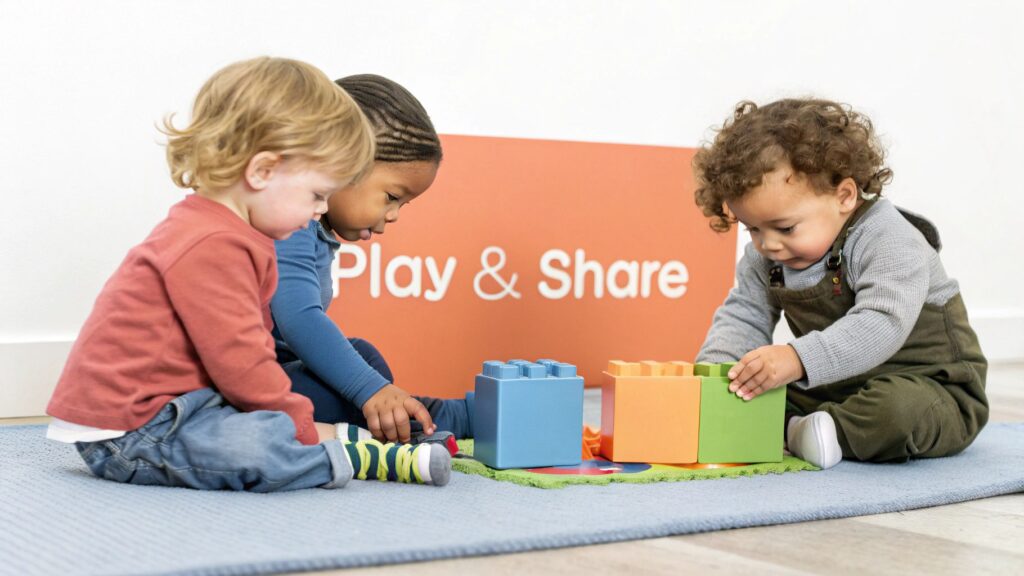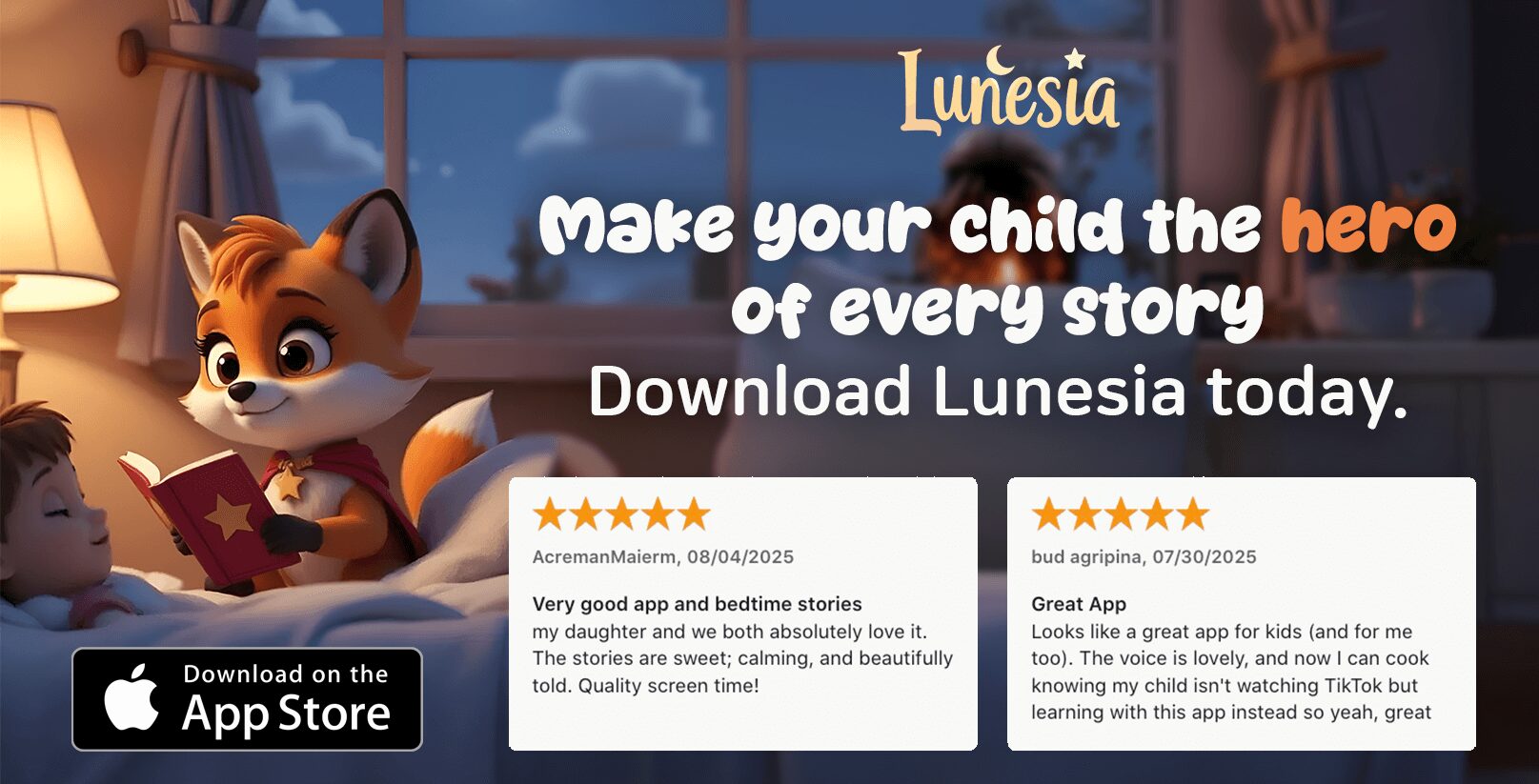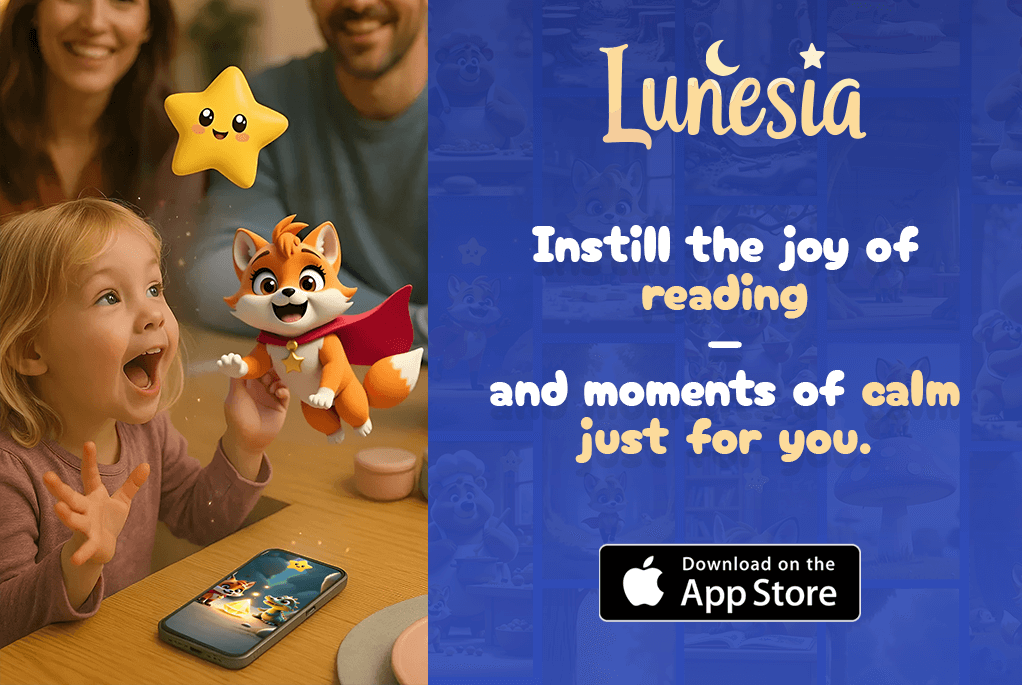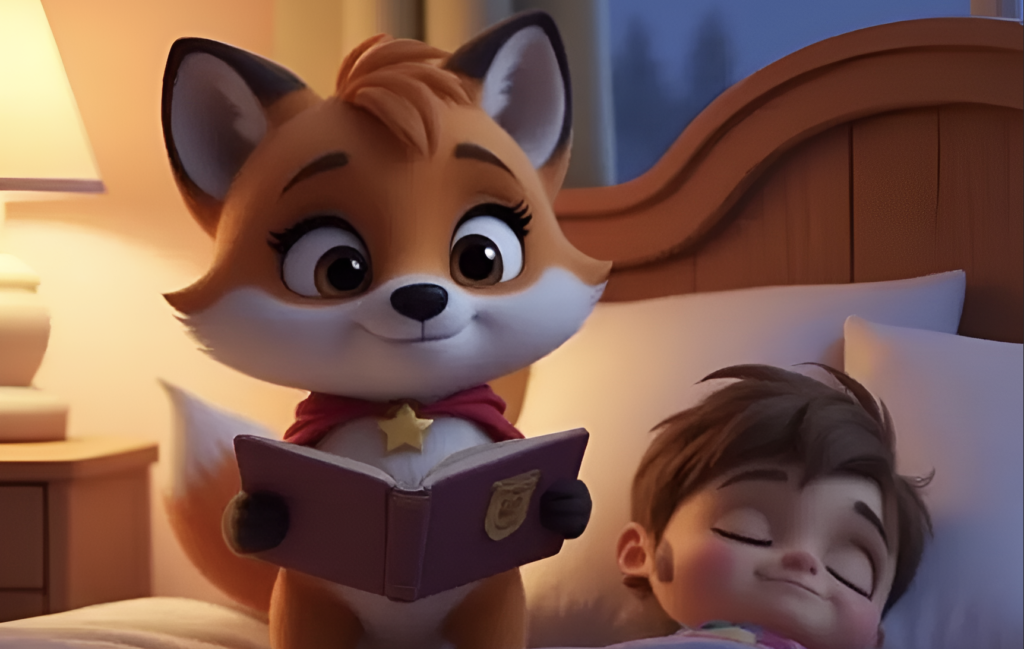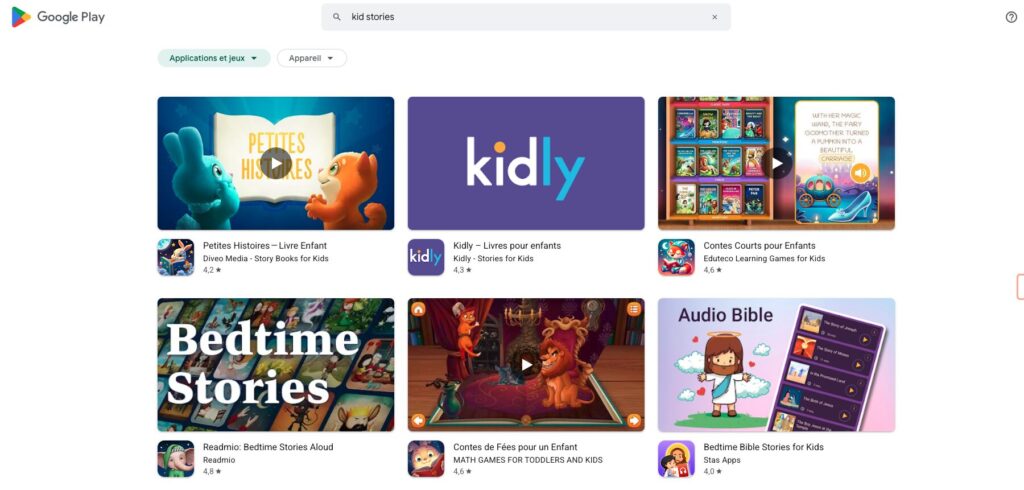Ever watch your toddler snatch a toy and wonder, "Is my child destined to be a tiny tyrant?" Let’s take a deep breath together. You're not alone, and you're raising a wonderful human, not a villain. Navigating the wild world of sharing, turn-taking, and gargantuan feelings is a monumental task for anyone, let alone a two-year-old. But what if these chaotic moments are actually golden opportunities in disguise?
What if you had a secret playbook filled with simple, fun social skills activities for toddlers that could turn tearful tantrums into powerful lessons in empathy? That's exactly what this is. We’re about to explore seven transformative activities that do more than teach manners—they build the very foundation of kindness, courage, and the emotional resilience your child needs to thrive. A staggering 80% of a child’s brain develops by age 3, making these early years the most critical window for emotional learning.
These aren't chores; they’re joyful games that build connection. And what about screen time? Could it actually be an ally in this mission? Imagine your child immersed in interactive stories where their choices shape the adventure, teaching kindness and problem-solving. Apps like Lunesia do just that, offering a safe, ad-free world for them to learn and grow—while you finally get that moment to breathe, completely guilt-free. Ready to turn playtime into a launchpad for lifelong social success? Let's dive in.
1. Turn-Taking Games
Ever wondered how to teach a toddler the almost mythical art of patience? Their world often operates on a "me, now!" frequency, which is completely normal. The secret isn't a long lecture on sharing; it's transforming the concept into a game they want to play. Turn-taking games are your first, most powerful tool, making them one of the most effective social skills activities for toddlers.
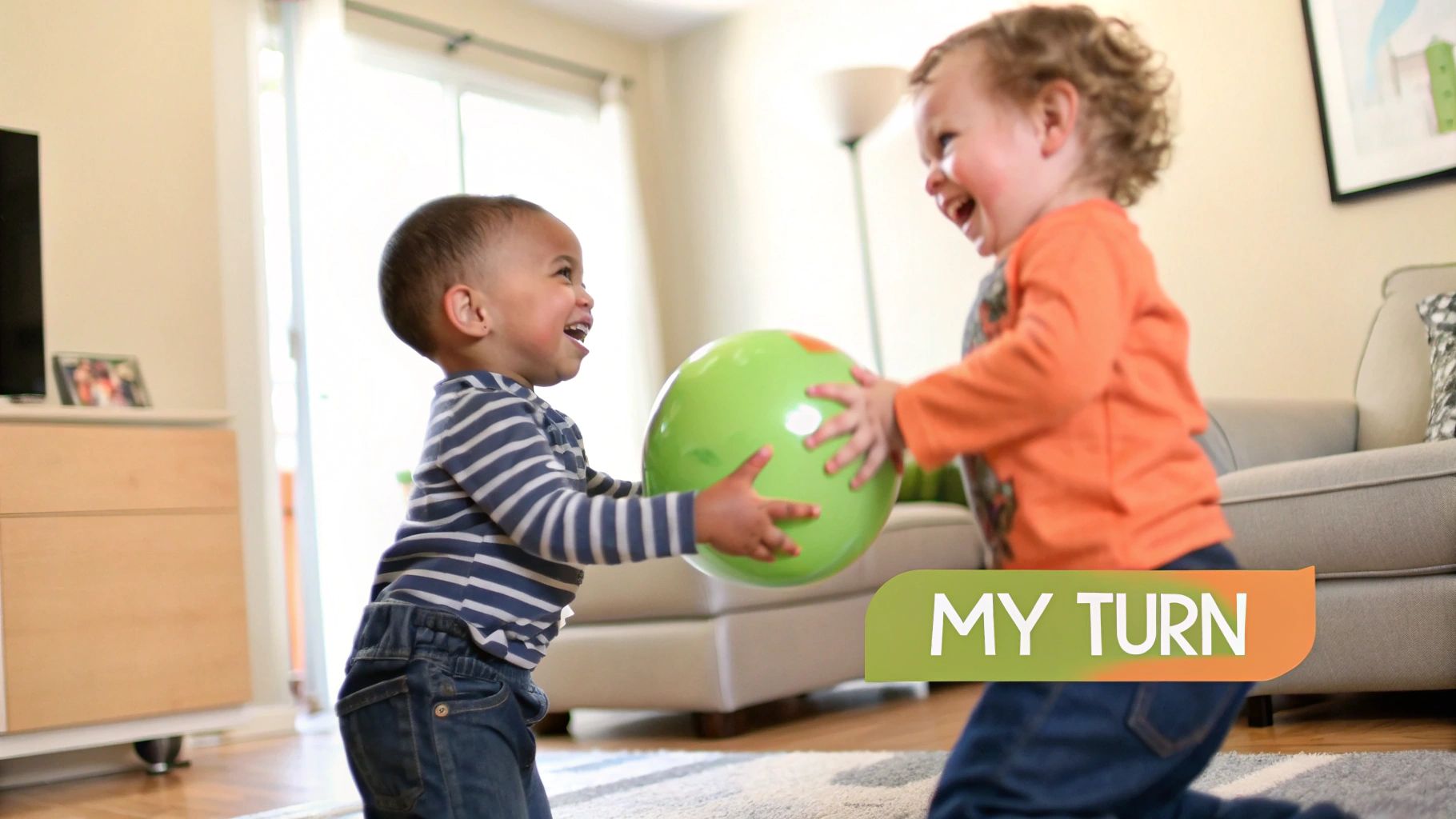
How do they work their magic? By creating a simple, predictable rhythm: my turn, then your turn. This repetitive pattern is a toddler’s best friend, helping their developing brain grasp impulse control and respect for others. They’re not just learning to wait; they're learning that waiting is part of the fun and that their turn is always just around the corner.
Simple Games to Start With
You don't need fancy equipment to unlock this superpower. The best turn-taking games use what you already have.
- Roll the Ball: Sit on the floor and roll a soft ball back and forth. Make it a ceremony. Use clear, exciting language: "Mommy's turn to roll!" and then, with a flourish, "Now it's your turn!"
- Build a Tower: Use just a few blocks. Take turns placing one on top of another. Celebrate the shared creation when it’s tall, and laugh together when it inevitably tumbles down. The goal isn't the tower; it's the teamwork.
- Driveway Chalk Art: Take turns drawing a line. "My turn to draw a swirly line!" Then, "Your turn to add a dot!" You're creating a shared masterpiece, one turn at a time.
Making Turn-Taking Stick
So how do you make this lesson actually sink in? Consistency and celebration are your secret weapons. Start with lightning-fast turns—maybe just 10-15 seconds—to match their fleeting attention span.
Most importantly, narrate the process like a sports commentator. Simple phrases like "My turn," then "Your turn" become powerful social cues. When they wait patiently, even for a heartbeat, celebrate it like they just won an Olympic medal! A cheerful "Great waiting!" goes a long way. This isn't just about blocks and balls; you're building the foundation for navigating friendships and classroom dynamics with unshakeable confidence.
2. Parallel Play Activities
Have you ever seen two toddlers playing in the same sandbox, utterly absorbed in their own little worlds, yet perfectly content? This isn’t them being antisocial; it’s a brilliant and crucial developmental milestone called parallel play. Think of it as the gentle warm-up act before the main event of cooperative play, making it one of the most powerful and low-pressure social skills activities for toddlers.
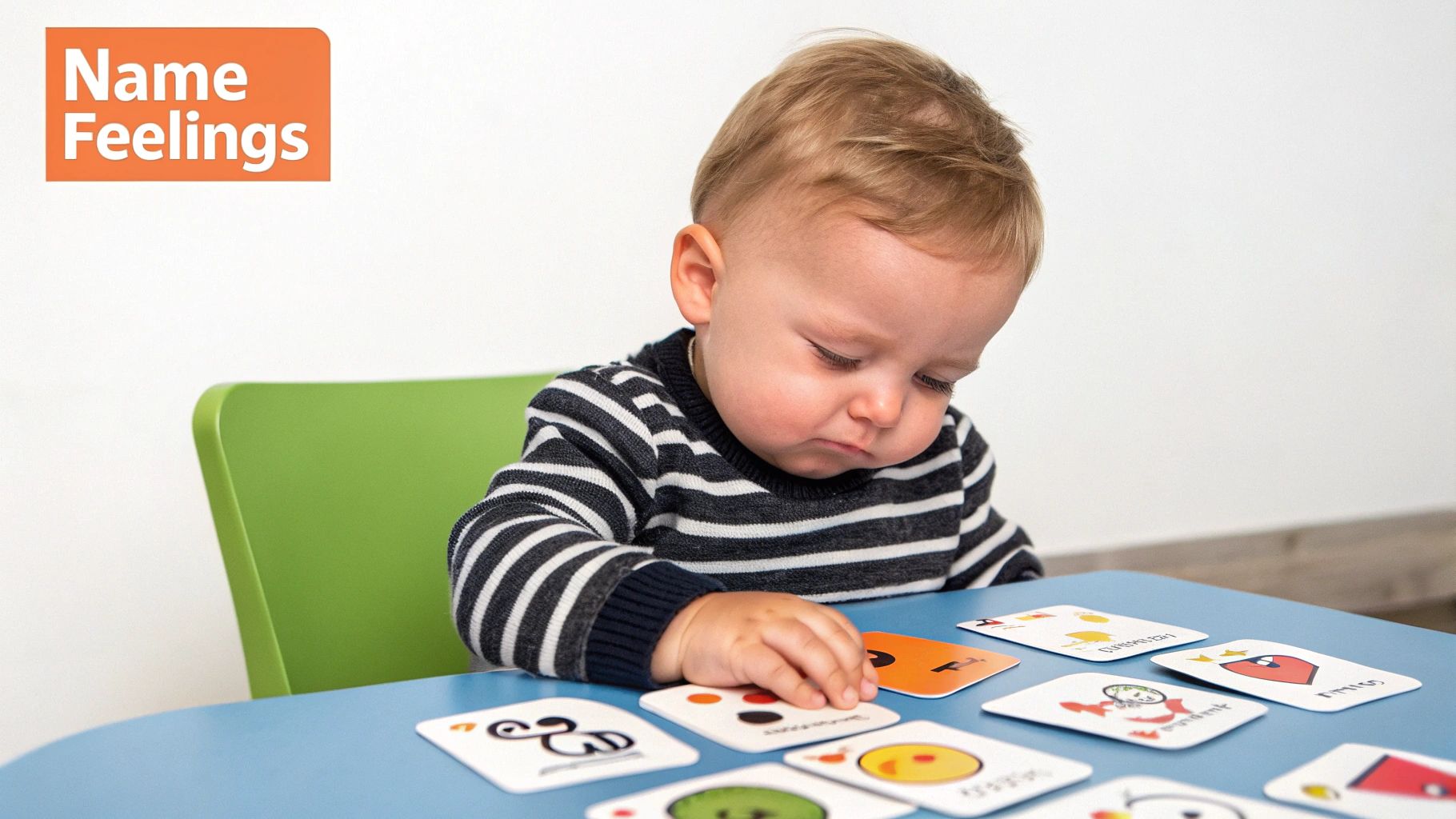
Pioneered by psychologist Mildred Parten, this stage is where children play alongside each other without directly interacting. They might use similar toys or even mimic one another, learning to be comfortable with peers before they're ready for the complex dance of cooperation. It’s like learning the rules of the road by watching traffic from a safe distance before getting behind the wheel. They're absorbing social cues without the pressure to share or negotiate—a genius setup for building social confidence.
Simple Activities to Get Started
How can you engineer this brilliant learning environment? It’s all about creating an inviting, shared space where conflict is minimized and independent exploration is celebrated.
- Side-by-Side Art Studio: Forget sharing one pot of paint. Set up two small easels or lay out large sheets of paper on the floor with separate sets of crayons or washable paint. They can create their own masterpieces while soaking in the creative energy of their friend.
- The Magic of Duplicate Toys: This is the ultimate hack for avoiding the dreaded "I had it first!" meltdown. Provide two bins with similar sets of building blocks, toy cars, or animal figures. This simple trick allows toddlers to focus on their play, not possession.
- Play-Doh Stations: Give each child their own lump of Play-Doh and a few cookie cutters. They're sharing the table and the experience, but not the exact tool at the exact same time.
Making Parallel Play Stick
Your role here is to be a facilitator, not a director. Resist the urge to force them to play together. The goal is comfortable coexistence.
Gently narrate what you see to build their awareness. Observations like, "You are building with blue blocks, and Liam is building with red blocks!" help them notice each other without demanding interaction. By allowing this natural progression, you're not just avoiding a fight over a toy; you're helping them build the confidence they need to eventually take that brave step into true cooperative play, all on their own timeline.
3. Emotion Recognition Activities
How do you explain what a feeling looks like to a toddler? They feel frustration, joy, and fear with the force of a hurricane, but connecting those feelings to a name or a face is like learning a new language. This is where emotion recognition activities become a game-changer. These aren't just about labeling "happy" or "sad"; they are about building the bedrock of empathy, making them non-negotiable social skills activities for toddlers.
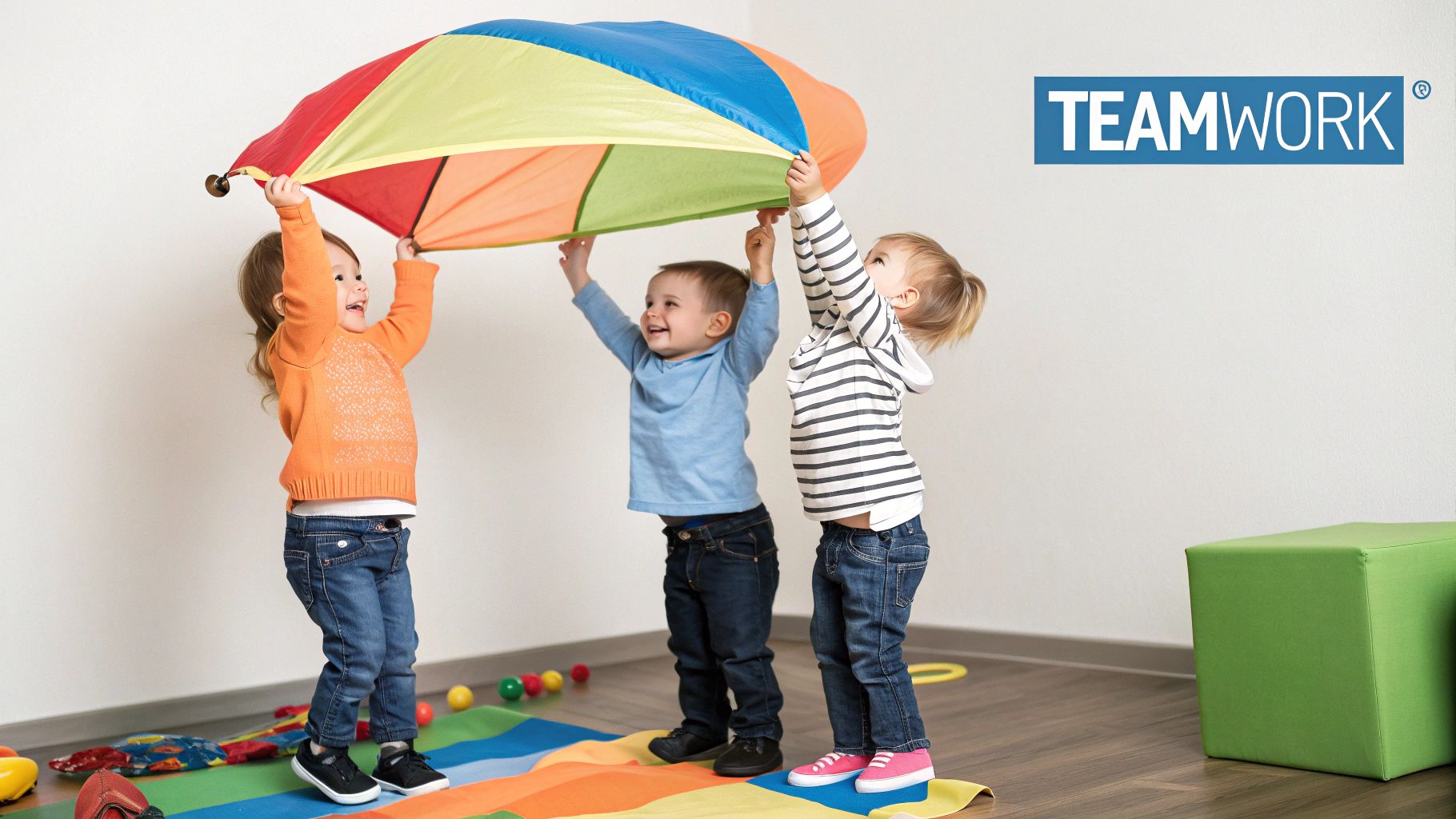
Why does this matter so much? Research shows that children with higher emotional intelligence are more successful in school and relationships. These activities make abstract feelings tangible. By using pictures, stories, and games, you give your child a "feelings dictionary" to understand their own inner world and, crucially, to recognize those feelings in others. That frown on their friend’s face suddenly means something—and that's the first step toward compassion.
Simple Games to Start With
Building emotional intelligence doesn't require flashcards; it can be woven playfully into your day.
- Feelings Face Mirror: Make a "mad" face in the mirror and ask your toddler to copy it. Then try a "surprised" face. This physical act connects the muscle movements to the emotion, creating a powerful mind-body link.
- Emotion Charades: Turn it into a silly game. "Can you show me what a silly face looks like?" Then, "Wow, that's a great silly face! How does my face look? I feel… happy!"
- Storybook Detectives: While reading, pause and become an emotion detective. Point to the characters' faces and ask, "How do you think the little bear is feeling right now? Look, his shoulders are slumped."
Making Emotion Recognition Stick
To truly anchor these concepts, integrate them into the messy, real moments of life. Instead of saying "Don't be sad," try validating their experience: "I see you're feeling sad because we have to leave the park. It's okay to feel sad." This simple shift from dismissing to naming is transformative. You can explore a wide range of emotional intelligence activities for kids to expand on these basics.
And what about those big, scary feelings? When a child feels overwhelmed by fear or anxiety, digital tools can offer a safe harbor. In a Lunesia story, a child might help a character who is scared of the dark, making choices that build courage. By navigating the character's fear, they are practicing how to handle their own, learning that all feelings are manageable. This builds real-world emotional resilience in a way that feels like pure fun.
4. Simple Cooperative Games
What if you could teach your toddler that the greatest win is one you achieve together? In a world that often screams "be the best," cooperative games whisper a more powerful message: "we are better together." These non-competitive activities are brilliant social skills activities for toddlers because they teach children to unite toward a shared goal, celebrate group success, and understand that everyone’s contribution matters.
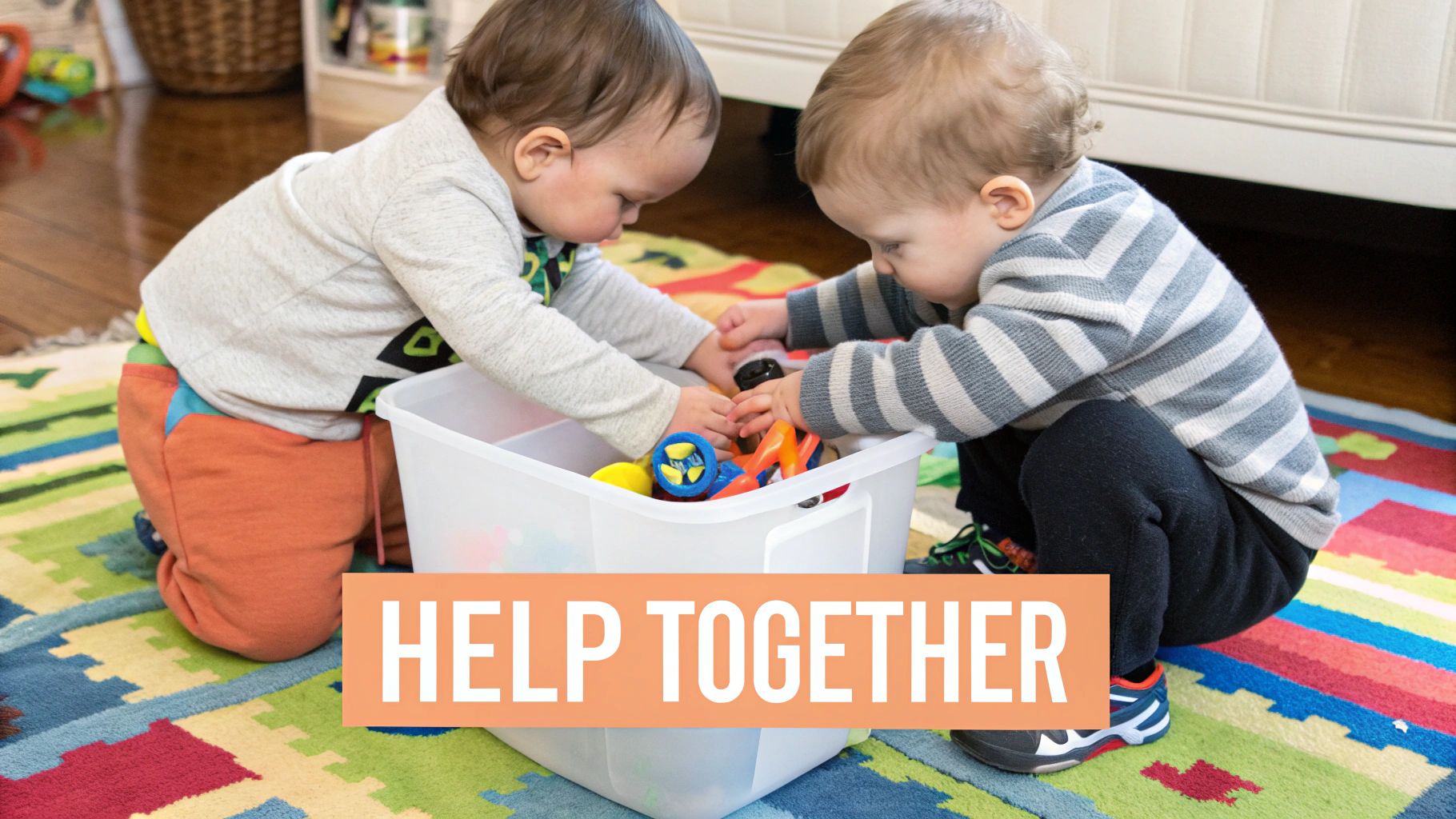
The concept is beautifully simple: everyone wins, or no one does. This removes the sting of losing and replaces it with a sense of unity and mutual support. Toddlers learn to communicate their ideas ("put the block here!"), listen to their friends, and combine their efforts. It's their very first lesson in the power of teamwork, a skill that will serve them for the rest of their lives.
Simple Games to Start With
You can introduce cooperative play with activities that are impossible to do alone.
- Group Art Mural: Tape a massive sheet of paper to the floor. Give everyone crayons or paint and declare a mission: "Let's create one giant jungle masterpiece together! You can draw the lion, and you can draw the monkey!"
- The Floor is Lava (Team Version): Scatter pillows and blankets across the floor. The goal isn't for one person to get across, but for everyone to get to the "safe island" (the couch) without touching the floor. They'll have to help each other!
- Feed the Monster: Decorate a cardboard box to look like a hungry monster. The goal is for the team to "feed" the monster by tossing all the soft balls or beanbags into its mouth.
Making Cooperative Play Stick
How do you ensure these games build teamwork instead of chaos? The focus must be on the process, not the outcome. Keep groups small to prevent anyone from feeling overwhelmed.
Narrate the teamwork you see happening. Phrases like "Look how you're all working together!" or "We did it as a team!" are like emotional high-fives that reinforce the value of cooperation. When the goal is achieved, celebrate the group's success with wild enthusiasm. This positive reinforcement teaches toddlers that collaborating is not only effective but also incredibly rewarding, laying the groundwork for a lifetime of empathy and strong friendships.
5. Greeting and Goodbye Routines
How do you teach a toddler the simple magic of "hello" and "goodbye" without it feeling like a forced performance? For little ones, social arrivals and departures can feel like being pushed onto a stage without a script. Creating fun, consistent routines transforms these anxious moments into opportunities for connection, making them essential social skills activities for toddlers.
Why do these rituals matter? They give toddlers a predictable script to follow, which builds their social confidence one interaction at a time. Instead of freezing up when Grandma arrives, they have a fun, rehearsed action to fall back on. This simple practice not only teaches social norms but also helps them feel more in control during transitions—a common trigger for those epic toddler meltdowns we all know and love.
Simple Routines to Start With
The key is to make these interactions playful and pressure-free. Let your child choose what feels comfortable.
- Offer a Greeting Menu: Empower them with choice. Instead of demanding a hug, ask, "Grandpa's here! Do you want to give him a high-five, a fist bump, or a secret silly wave?" This gives them a sense of control over their own body and interactions.
- Sing a Song: Create a goofy "hello song" you sing whenever someone arrives or when you join a playgroup. A simple "goodbye song" can also turn a difficult departure into a sweet, predictable ritual.
- The Window Wave: Make leaving a special ceremony. After saying your goodbyes inside, have the person who is staying wave from a specific window. This creates a reassuring final connection that can ease separation anxiety.
Making Greetings Stick
Consistency is your superpower here. Model the warm, friendly behavior you want to see by enthusiastically greeting people yourself. If your child is feeling shy, never force it. Instead, be their safe base. Say, "I'm going to say hello to our friend. You can wave from behind my leg when you're ready."
Narrate these moments to make the expectations clear. Simple phrases like "Time to say hello!" or "Let's wave goodbye" create obvious social cues. When they make an effort, no matter how small, praise it specifically: "That was such a friendly wave!" This positive feedback helps them associate greetings with feeling confident and connected, paving the way for a lifetime of smoother social interactions.
6. Sharing and Helping Activities
How do you teach generosity to a toddler whose entire world currently revolves around the word "Mine!"? Let's be honest: a lecture on selflessness is about as effective as reasoning with a hungry velociraptor. The key is to make these abstract virtues tangible through purposeful action. Sharing and helping activities are concrete experiences that transform prosocial behaviors from a dreaded rule into a rewarding part of life, making them crucial social skills activities for toddlers.
How does this work? These activities link positive feelings—a sense of competence, connection, and belonging—to the acts of giving and assisting. When a toddler helps you put away toys or offers their friend a cracker, they feel important and capable. They learn that their actions can make someone else happy, a foundational building block for developing genuine empathy and kindness.
Simple Activities to Start With
You don't need a special curriculum; it's about reframing everyday moments as opportunities for teamwork.
- Cleanup Crew Heroes: Turn tidying up into a mission. Put on some "superhero music" and say, "Okay, Cleanup Crew! Your mission is to put all the red blocks in the bin! Can you help me?" This frames chores as teamwork, not a command.
- The Snack Time Helper: During snack time, make them your official assistant. "Can you help me give a napkin to everyone?" This gives them a powerful role and introduces the idea of distribution and care.
- Toy-for-a-Toy Trade: When another child wants their toy, instead of just saying "share," teach them to trade. "You can have a turn with the truck when your friend is finished. Would you like to offer them the blue car to play with while you wait?"
Making Sharing and Helping Stick
For these lessons to resonate, they must be consistent and genuinely celebrated. Start by creating opportunities where sharing is easy—like with a big bowl of crayons, not a single, prized lovey.
Most importantly, catch them being kind and narrate their positive actions. Simple phrases like "You helped me so much!" or "That was so kind of you to share" are powerful reinforcers. Celebrate the effort, even if the execution isn't perfect. By modeling this behavior and cheering on their contributions, you are nurturing a spirit of cooperation that will last a lifetime. For more ways to cultivate these values, you can explore further kindness activities on lunesia.app.
7. Group Circle Time
How do you teach a toddler to feel like part of something bigger than themselves? It's a huge concept, but the answer often starts small—by sitting in a simple circle on the floor. Group circle time is a preschool classic for a reason: it’s a structured ritual that gently guides toddlers to listen, share, and see themselves as part of a community. This activity transforms a room of individuals into a team, making it one of the most powerful social skills activities for toddlers.
This ritual creates a safe and predictable space where every child feels seen. By participating in songs, stories, or simple conversations, toddlers learn the rhythm of group communication: we listen when others speak, we wait for our turn to share, and we follow group instructions. They begin to understand that their voice matters, but so do the voices of their friends—a lesson in mutual respect.
Simple Circle Time Ideas
You don't need a classroom to host a circle time. A few minutes on the living room rug with family or a couple of friends works wonders.
- The Name Song: Start with a simple "hello" song that names each child and adds a fun action, like clapping or stomping for their name. This immediately makes every toddler feel seen and included.
- Interactive Storytelling: Choose a book with a repetitive phrase. Encourage the children to shout it out with you, turning a passive story into a shared adventure. This is exactly the principle behind apps like Lunesia, where children don't just listen; they participate, making choices that drive the narrative forward.
- Weather Watchers: Gather by the window and become a team of meteorologists. "What do you see today? Is it sunny or cloudy?" This teaches observation and shared conversation skills.
Making Circle Time a Success
What's the secret to a great circle time? Keep it short, engaging, and flexible. For toddlers, 10 minutes is often the sweet spot. A predictable routine, like starting and ending with the same song, helps them feel secure.
Above all, make it interactive. Use puppets, fingerplays, or simple instruments to hold their attention. Gently narrate the social rules with phrases like "It's Sarah's turn to share," and "Let's all use our listening ears." When a child participates, offer specific praise: "Thank you for sharing your great idea!" This builds their confidence and reinforces the incredible value of being an active, respectful member of a group.
7 Social Skills Activities Comparison
| Activity | Implementation Complexity 🔄 | Resource Requirements ⚡ | Expected Outcomes 📊 | Ideal Use Cases 💡 | Key Advantages ⭐ |
|---|---|---|---|---|---|
| Turn-Taking Games | Moderate – requires consistent adult supervision and timing cues | Low – minimal materials like balls or instruments | Builds patience, self-regulation, and social respect | Teaching patience and turn order in small groups | Develops self-control and social communication |
| Parallel Play Activities | Low – setup of similar materials side-by-side | Moderate – duplicate materials for each child | Increases social comfort, observation, and imitation | Encouraging social awareness without pressure | Supports individual pace toward social interaction |
| Emotion Recognition Activities | Moderate – needs structured materials like emotion cards and stories | Moderate – visual aids and role-play props | Enhances emotional intelligence, empathy, and communication | Teaching emotional vocabulary and recognition | Builds empathy and emotional self-awareness |
| Simple Cooperative Games | High – requires adult facilitation and clear group roles | Moderate – shared materials for group efforts | Promotes teamwork, problem-solving, and shared responsibility | Fostering collaboration and group problem-solving | Strengthens cooperation and reduces conflict |
| Greeting and Goodbye Routines | Low – consistent verbal/physical prompts | Low – none or simple visual aids | Builds social confidence and communication skills | Daily social rituals to ease transitions | Establishes routine and cultural social norms |
| Sharing and Helping Activities | Moderate – structured guidance and patience needed | Low – concrete shared materials | Develops empathy, generosity, and peer relationships | Teaching prosocial behavior through hands-on help | Reinforces empathy and positive social behaviors |
| Group Circle Time | Moderate to High – skilled facilitation and routine needed | Low – minimal materials like books and instruments | Improves group participation, attention, and community sense | Group engagement and early social skills | Builds listening and group belonging skills |
Your Partner in Raising Kind, Confident Kids
You've just armed yourself with a fantastic playbook of social skills activities for toddlers, from the simple rhythm of turn-taking games to the shared joy of a group mural. Each one is a powerful building block, carefully placed to construct a strong foundation for your child's entire emotional future. We've seen how parallel play creates a safe space for toddlers to simply be together, and how emotion games give them the words for their big, overwhelming feelings.
But let's be real. The journey of raising a kind, confident child isn't a checklist; it's woven from thousands of small, consistent moments. It's in the way you help them navigate a squabble over a toy, praise them for helping set the table, or create a silly goodbye routine. These daily interactions are where the real magic happens. The key takeaway? You already have everything you need. Your presence and your patient guidance are the most powerful tools in your arsenal.
Turning Daily Routines into Learning Opportunities
Think of yourself as an emotional coach, turning every interaction into a chance to practice.
- During snack time: "Can you help me pass a cracker to your brother? Thank you, that was such a kind thing to do!"
- When a tower crashes: "Oh no! It looks like your friend is feeling sad that the tower fell. What could we do to help him feel better?"
- At the park: "Let's practice taking turns on the slide. You go first, and then we'll cheer for the next person!"
These gentle nudges transform everyday life into a dynamic classroom for social learning. You are your child’s most important guide, showing them how to navigate their world with kindness and confidence.
But what happens in those moments when you just need a break? The laundry is piling up, you haven't finished your coffee, and you feel the guilt of screen time creeping in. What if that screen time could be your secret weapon, actively reinforcing the very skills you're working so hard to teach?
This is where Lunesia comes in. Imagine your child not just watching a cartoon, but becoming the hero of an interactive adventure. A world where they make choices that teach them about courage when facing a shy dragon, or practice empathy by helping a lost star find its way home. Our stories are specifically designed to be a safe, ad-free playground for your child to explore complex emotions and social scenarios. While they’re joyfully learning to be a good friend or a brave problem-solver, you get that precious, much-needed moment to recharge—completely guilt-free. Lunesia isn't just another app; it's your co-pilot in parenting, turning quiet time into powerful, meaningful growth.
Ready to transform storytime into your most powerful tool for teaching social-emotional skills? Download Lunesia today and watch your child become the hero of their own learning adventure. Discover a world of interactive, value-rich stories at Lunesia and give both your child and yourself the gift of confidence, kindness, and peace of mind.
